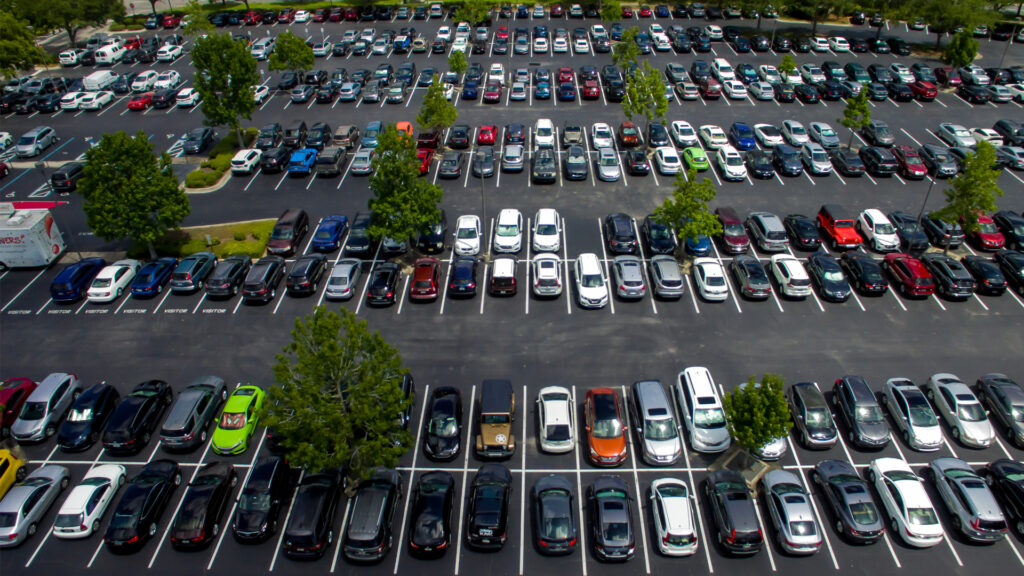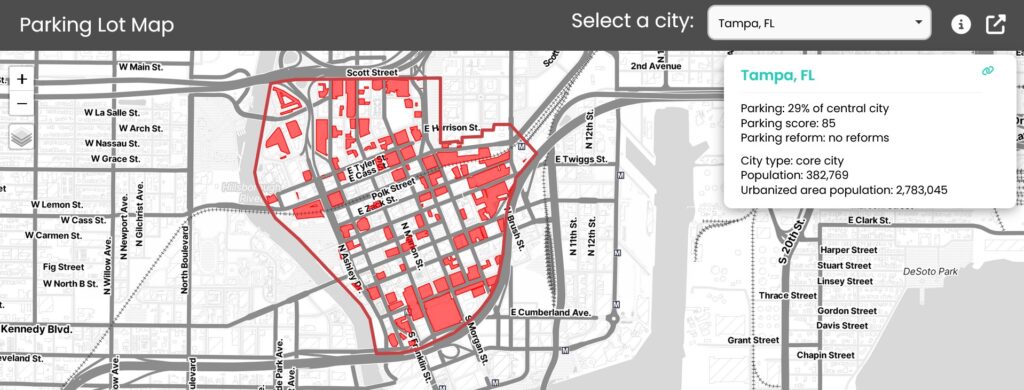By Bella Kubach, The Invading Sea
Some of Florida’s largest cities dedicate much of their downtowns to parking, with parking lots covering at least 30% of the city centers in Fort Myers, Melbourne and Orlando, according to a recent study by the Parking Reform Network.
The Parking Reform Network, a nonprofit group that educates the public on parking policy, analyzed the core city centers of 100 major cities across the U.S. to determine how much of their land was dedicated to parking.
The study determined that several Florida cities averaged more parking in their city centers than many other urbanized areas of their size, including Melbourne (35%), Orlando (33%), Fort Myers (30%), Sarasota (29%), and Tampa (29%).

The amount of parking in most city centers is problematic because it decreases walkability and causes housing scarcity, according to the study.
“It reinforces car dependency,” said Tony Jordan, president of the Parking Reform Network.
Car dependency has environmental impacts such as greenhouse gas emissions that contribute to global warming. But Jordan said the pollution that cars emit is not the only problem.
During the summer, dark asphalt lots absorb heat and create the urban heat island effect in parking-lot-abundant cities. The urban heat island effect refers to the process that causes urban areas to become significantly warmer than rural areas because buildings and roads absorb more heat than natural landscapes.
Jordan said the more frequent rain events caused by climate change also put some core cities at risk of their surface lots flooding.
The Parking Reform Network’s study gave cities a “parking score” that measures the amount of land a city uses for parking compared to other cities with a similar urbanized area population. Cities with higher scores dedicate more land to central city parking.
Out of the cities scored, Tampa ranked fifth highest with a score of 85. Other Florida cities such as Orlando (69), Fort Myers (57), and Sarasota (52) followed not too far behind.

But despite Tampa’s high score, Tampa officials say they are making walkability a big priority.
“We are investing revenues from our parking collections to enhance walkability through the construction of new sidewalks and bike lanes,” said Josh Cascio, communications coordinator for the city of Tampa’s Mobility Department, in an email.
According to Cascio, Tampa uses its parking revenue to encourage visitors and residents to walk and bike around the city.
“In fact, we spend hundreds of thousands of dollars a year on sidewalk maintenance,” Cascio said.
To further promote walkability, Cascio said Tampa also uses parking revenue to help pay for free public transit, and its maintenance of traffic signage keeps pedestrian walkways open even during ongoing construction.
However, despite Tampa’s efforts to encourage walkability, the study found that 29% of its city center is dedicated solely to parking. Jordan thinks that parking reform should be a priority.
“Parking policy not only impacts the climate, but it impacts housing, economic development and transportation policy as well,” Jordan said.
But he is aware of the political struggle to transform current parking into other structures. Still, he urges cities to get rid of parking mandates and to create more walkable neighborhoods.
“The solution is let’s legalize and build more walkable neighborhoods. I don’t really know what the alternative argument is to that because it seems pretty simple, and that shouldn’t be very controversial.”
Bella Kubach is a Florida Atlantic University senior majoring in multimedia journalism who is reporting for The Invading Sea during the spring 2024 semester.
Sign up for The Invading Sea newsletter by visiting here. If you are interested in submitting an opinion piece to The Invading Sea, email Editor Nathan Crabbe at ncrabbe@fau.edu. To learn more about the urban heat island effect, watch the video below.




Cities should eliminate minimum parking requirements, especially for development near transit.